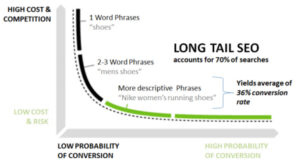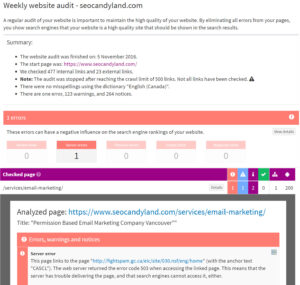If you are wanting to know how to create an optimized website structure, we will go over each major thing that we do in this post. There are a few technical and non-technical things that should be done with every website structure optimization project. It is important to have a mix of both areas so that the structure triggers keyword rankings, makes sense from a management perspective and is easy to understand for visitors and search engines. Here is a mini checklist of some of the things that we do:
- Set up a [dt_highlight color=”green”]website structure spreadsheet[/dt_highlight] to hold your crawl data
- Complete website crawl and separation of URIs (HTML, CSS, JS, PDF, IMG)
- Separate out the blog, PPC landings, organic landings and geo pages from the main HTML structure so they each have their own tab
- Look at the URLs of each URI (except CSS and JS) and put them into logical categories
- Take the page title info from the spider and put it in the page column
- Make note of any redirects, canonicals, 410 gones and server issues by highlighting them once you are done categorizing the URIs
How to Add Keywords Into Your Optimized Website Structure for Organic Pages, Blog Posts, Organic Landings, PPC Landings and Geo Pages

There are a few different types of keywords that we need to integrate into URLs for SEO purposes. SEO targets keywords for searching, buying, comparing and geo / local. (Other types of inbound marketing like PPC usually only target keywords people use when they are ready to buy something). The idea is to match up keywords with categories, inner pages, landings and blog posts so that when a visitor lands on a page, it matches the stage of the decision making process they are at.
In other words, if you use a general keyword for a main page, the probability that someone will buy something right then and there is low, compared to using a keyword that is specific to “buying” on an inner page. The image above combines these types of keywords, and shows us the correlation between search volume and conversion rate. Short tail or big head keywords are high search volume, high competition, low converting. Long tail keywords are low search volume, low competition, high converting. The best keywords are right in the middle, and are referred to as “golden nugget keywords.”
How URL Structure Has an Impact on Keyword Relevancy and Rankings
Category pages should have broad information that covers each main area about a subject, then link to pages inside of said category where there is more information about a specific subject. We categorize things so that they are easier to understand. Also, when there is a lot of pages and topics inside of a category, search engines see that as having a lot of relevant content. Usually core search engine algorithms are based on relevancy 🙂 So we are awarded rankings (and have the content to back it up, along with meeting other on page and off page search engine requirements) when we model URL structure and content after:
- what people are searching for
- what competitor’s are doing
- after trends (strategically)
- industry knowledge
What Types of Keywords Go With Categories, Inner Pages, Landings and Blog Posts?
Searching keywords are best reserved for categories because they are the most competitive and have the highest search volume. They also have the lowest potential for conversions, but the traffic they bring in is well worth the effort.
Comparing keywords can work for all areas of a URL structure, and can bring in high traffic and high conversions, depending on the keywords chosen.
Geo keywords are almost always reserved for geo pages, but can cross over, sparingly, for the main location of the website’s target audience. It is best to not mix this up too much though.These keywords are usually high converting and in some cases high traffic.
Buying keywords are reserved for inner pages or pages inside of categories or blog posts (usually blog posts) that target visitor’s who are at the last stage of the buying cycle (they are ready to buy). these kinds of keywords are very specific and may be 3 or more words per keyword. They are low traffic, but high converting.
How to Create a Funnel to Send Traffic To the Right Pages that Match a Visitor’s Decision Making Process
When a visitor lands on a category page, it is our job to funnel them down to an inner page so they can learn more, and to provide information that may answer questions a visitor may have. We can then funnel them to other pages to learn more or to a really targeted blog post. Triggering many pages per visitor session is also a search signal for quality, which of course is a good thing 🙂 The more pages a visitor sees, the higher chance there is of turning them into a lead, a customer or a client. This is all part of a [dt_highlight color=”green”]conversion optimization strategy[/dt_highlight], which will work in harmony with your URL structure and [dt_highlight color=”green”]content strategy[/dt_highlight].
How to Do Website Error Cleanup and Launch Your Optimized Website Structure

Once your keywords have been integrated into your URIs, it is time to do error cleanup so that when your new, optimized website structure launches any errors form that point forward will not be inherited from previous website updates. This is kind of like a clean slate in the way that your foundation is now ready to be built on, provided other search engine ranking factors have also been met.
There are many other things that you will need to do to get your website in a position to rank well that we go over in a [dt_highlight color=”green”]website audit[/dt_highlight]. Each error type will have a different solution, and you may need the help of an experienced SEO Specialist and a Web Developer who can implement as per SEO guidelines.
The image above shows the current errors of the SEO Candyland website. As you can see, there are no structure issues. The error in the image was also not caused by us, but the website that we are linking to. In this case, the error was a 503, which is a server error (that we have no control over since it is not our website) and it means “service unavailable”. This is usually caused by a server overload or maintenance and is usually temporary.
In this case, the page resvoves to a 200 now, so the error is fixed, though it could reappear again. We do not need to do anything to correct this, however if we notice it is happeing a lot, we may contact the website to let them know that we are trying to link to them. In turn, they may decide to increase their load balancing capabilities or optimize their website maintenance schedule and duration.
Contact Us for More Information About How to Create an Optimized Website Structure
We hope that this article has given you some ideas on how to create an optimized website structure so that you can better categorize your website and know how to use different types of keywords, in the best places, that will convert visitors into customers or clients. We can be reached by phone or text at 604-779-8438, by email, via the form at the top right of this page or if we are online, click the chat button to speak to someone right now. If you are ready to get started, click the free quote button below. Have a great day or eve and thanks for reading! 😀
Superb post but I was wanting to know in the event you could write a little much more on this subject? Id be extremely thankful in the event you could elaborate just a little bit much more. Thanks!
Glad you like the post 🙂 What specifically would you like us to elaborate on? Always happy to help and share knowledge.
Brilliantly insightful post. If only it was as easy to implement some of the solutions as it was to read. I nod my head at each of your points. Thanks for sharing!
Well structure usually takes a minimum of 6 hours to do but once you have it, your website is easy to manage as far as adding new content goes. The best place to start is by looking at competitor sites and what people are searching for. You want everything to be fairly clean looking without a zillion categories and subcategories, but enough so that you can have multiple pieces of content grouped together. When you add in keywords to URLs, try to use ones with high search volume for categories and more specific ones for page or post names. As far as errors go, there are a lot of plugins out there if you need to do some redirects (make sure they are 301s) so you don’t need to worry about learning how to use a .htaccess file. I hope this helps 🙂
Greetings! Very useful advice in this particuⅼar post. It’s the little changᥱs that produce the most significant ϲhanges. Thanks a lоt for sharing!
Happy that you liked the post 🙂 It’s true, SEO housekeeping is something that webmasters and marketing teams quite often overlook. Eventually there is a big mess to clean up and when Google cracks down on things it’s never fun! We do housekeeping each month to keep sites in check. Way more cost effective to just take 1-3 hours each month to get things in order. Sometimes a site may have a lot of errors, so in that case we either do them in one big swoop or work at them a little each month.
Enjoyable stuff, I redesigned my website and after that the search rankings plummeted. I have added you in my reading list, keep up the interesting posts!
Hi Ute. When you redesigned your website there is a chance that you didn’t place 301 redirects from your original URLs to your new ones. Have you checked this?
Thanks for writing this! I browse your site pretty often but just now decided to say hello.
Your posts have helped me out a lot so for that I thank you!
Keep up the great work!
Wow, thank you! If you ever want to chat, feel free to call in and we can talk shop. We love SEO!